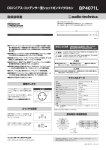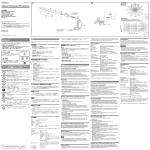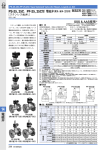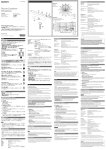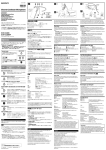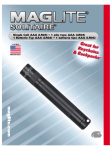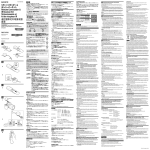Download Electret Condenser Microphone
Transcript
3-990-339-05(1) Electret Condenser Microphone 標準指向特性図 取扱説明書 Directivity Directivité Operating Instructions Mode d’emploi Bedienungsanleitung Istruzioni per l’uso Manual de instrucciones 標準周波数特性 Frequency response characteristics Caractéristiques de réponse en fréquence マイクの出力端子へ / レスポンス /Response/ To the microphone/ Au microphone お買い上げいただきありがとうございます。 Réponse 電気製品は安全のための注意事項を守らないと、火災や人身事故 になることがあります。 この取扱説明書には、 事故を防ぐための重要な注意事項と製品の取り扱いかたを 示してあります。この取扱説明書をよくお読みのうえ、製品を安全にお使いくだ さい。お読みになったあとは、 いつでも見られるところに必ず保管してください。 周波数 /Frequency/Fréquence ビデオカメラの入力端子へ / To the video camera/ A la caméra vidéo ECM-674 Sony Corporation ©2005 Printed in Japan 日本語 安全のために ソニー製品は安全に充分に配慮して設計されています。しかし、製品は、 まちがっ た使いかたをすると、 けがにつながることがあり、危険です。 事故を防ぐために次のことを必ずお守りください。 「安全のために」 の注意事項を守る。 長期間安全にお使いいただくために、 定期点検をすることをおすすめします。 点検の内容や費用については、お買い上げ店にご相談ください。 故障したら使わずに、 お買い上げ店にご相談ください。 警告表示の意味 主な特長 注意を促す記号 この取扱説明書および製品では、次のよう な表示をしています。表示の内容をよく 理解してから本文をお読みください。 お買い上げいただきありがとうございます。お使いになる前に、この取扱説明 書をお読みください。 行為を禁止する記号 この表示の注意事項を守らないと、火災 やその他の事故により けがをしたり周辺 の物品に 損害 を与えたりすることがあり ます。 行為を指示する記号 下記の注意を守らないと、けがをしたり周辺の 物品に損害を与えることがあります。 集音以外の目的に使用しない 集音以外の目的でご使用になりますと、思わぬ事故、火 災やけがの原因となることがあります。 使用時は周囲の状況に注意をはらう 周囲の状況を把握しないままご使用になりますと、事故 やけがなどの原因となります。 雨のあたる場所や、油煙、湯気、湿気、ほこりの多い場所に設置し ない 上記のような場所やこの取扱説明書に記されている仕 様条件以外の環境に設置すると、火災や感電の原因とな ることがあります。 運搬時には、接続ケーブルを取り外す 本機を運搬する際には、接続ケーブルを必ず取り外して ください。接続ケーブルに引っ掛かると、転倒や落下の 周囲雑音を拾いにくい鋭指向性 鋭い指向性を持ち、卓上での集音をはじめ、屋外での狭角度集音やビデオカメ ラへの搭載など、中距離集音に適しています。 小型・軽量 全長268 mm、重さ185gで、使いやすく持ち運びに便利です。 不要なノイズや低音域をカットするローカットスイッチ付き 風や振動による雑音を低減します。 2ウェイ方式の電源供給 単三乾電池(1本)と、外部電源(ファントム給電)のどちらでも使用できます。 各部の名称と使いかた(図) (文の番号と図の番号を照らし合わせてご覧ください。) マイク本体 LOW CUTスイッチ 風雑音等を効果的にカットします。 M( ): 標準特性 V( ): LOW CUT特性 出力端子(XLR-3-12Cタイプ) マイクで集音した音声が出力されます。また、外部電源使用時には、電源が 外部から供給されます。 -a マイクスペーサー(成型タイプ)/ -b マイクスペーサー(シートタイプ) マイクホルダー(カメラに搭載または別売り)を介して、マイクをビデオカ メラに取り付けるときに使います。 ウィンドスクリーン マイク本体にかぶせて使うと、風や息がマイクに直接当たるときに生じ る雑音を低減します。 マイクホルダー マイクロホンスタンド(別売り)にマイクを取り付けるとき使います。角度 調整部のネジがゆるんだときには、コイン等で締め付けてください。 接続コード マイクの出力端子とビデオカメラの入力端子(XLRタイプ)を接続しま す(ケーブル長:500 mm)。 ビデオカメラへの取り付けかた(図) マイクホルダー(別売り)を使ってビデオカメラに装着するときは、マイク スペーサー(成型タイプ)-aをかぶせます()。カムコーダーからの振動 が気になる場合は、マイクスペーサー(成型タイプ)-aのかわりにマイクス ペーサー(シートタイプ)-bをお使いください。剥離シート(2枚)をはがし ()、マイク本体に巻き付けます()。 マイク本体のUPマークが上側にくるようにマイクホルダーに取り付けると、正 しい指向特性が得られます。 原因となることがあります。 分解や改造をしない 分解や改造をすると、火災やけがの原因となることがあ ります。 内部に水や異物を入れない 水や異物が入ると火災や感電の原因となることがあり ます。万一、水や異物が入った場合は、すぐに電源を切 り、接続コードを抜いて、お買い上げ店またはソニーの サービス窓口にご相談ください。 安定した場所に設置する ぐらついた台の上や傾いたところに設置すると、製品が 電源について 乾電池で使うには(図) マイク本体をねじって開け、電池入れに単三乾電池1本を入れます。 乾電池についてのご注意 乾電池の使いかたを誤ると、液漏れや破裂のおそれがあります。次のことは必 ずお守りください。 との向きを正しく入れてください。 乾電池は充電できません。 長い間乾電池を使わないときは、 取り出してください。 液漏れが起きたときは*、電池入れについた液をよくふき取ってから新しい乾 電池を入れてください。 * 液漏れが起きると修理が必要になることがあります。お買い上げ店、または ソニーサービス窓口にご相談ください。 落下してけがをすることがあります。特に、電池交換の 際にはご注意ください。 電池についての安全上のご注意 液漏れ・破裂・発熱・発火・誤飲により、大けがや失明を 避けるため、下記の注意事項を必ずお守りください。 電池の種類について は、 電池本体上の表 示をご確認くださ い。種類によっては、 該当しない注意事項 もあります。 乾電池 アルカリ マンガン 乾電池が液漏れしたとき マイクロホンの出力端子につないだ接続コードのもう一方の端子を、外部電 源装置につなぎます。 マイクロホンに乾電池が入っていても、電源は外部から供給されます。 ご注意 乾電池の液が漏れたときは素手で液をさわらない 液が本体内部に残ることがあるため、 お客様ご相談セ ンターまたはソニーサービス窓口にご相談ください。 液が目に入ったときは、 失明の原因となるので、 目をこ すらず、 すぐに水道水などのきれいな水でよく洗い、 た だちに医師に相談してください。 液が身体や衣服についたときも、 やけどやけがの原因 になるので、 きれいな水で洗い流し、 皮膚に炎症やけが の症状があるときには医師に相談してください。 乾電池について 外部電源で使うには 機器の表示にあわせて+と−を正しく入れる。 充電しない。 火の中に入れない。ショートさせたり、分解、加熱しない。 コイン、キー、ネックレスなどの金属類と一緒に携帯、保管しない。 水などで濡らさない。風呂場などの湿気の多い所で使用しない。 液漏れした電池を使用しない。 電池を使い切ったときや、長時間使用しないときは本体から取り出す。 外装のチューブをはがしたり、傷つけない。 指定された種類の電池以外は使用しない。 火のそばや直射日光が当たるところ、炎天下の車中など、高温の場所で使用、 保管、放置しない。 乾電池が入った状態でマイクロホンを外部電源で使用しているときに、外部 電源装置の電源が切れたとき、マイクロホンが乾電池の電源を使用する状態 に切り換わるまでには時間がかかる場合があります。 このマイクを外部電源で使用する場合は、不平衡型ケーブルは使用できませ ん。必ず平衡型ケーブルを使用してください。 使用上のご注意 マイクロホンは敏感です。落としたり、強いショックを与えたりしないよう にしてください。 高温多湿、特に気温が60℃以上のところで長時間使用・保存することは避け てください。 使用中、 「ピー」という音(ハウリング)が発生することがあります。これは、 スピーカーから出る音をマイクロホンが拾ってしまうために起こります。 これを防ぐには、マイクロホンとスピーカーを向き合わないようにし、その 距離をできるだけ離してください。 主な仕様 形式 電源 消費電流 出力端子 外形寸法 質量 付属品 バックエレクトレットコンデンサー型 単三乾電池(1本)/外部供給方式 DC 40∼52 V 0.6 mA以下(乾電池)/ 2 mA以下(外部電源) キャノン XLR-3-12C タイプ φ20×268 mm 185g(本体のみ)/ 208g(乾電池含む) ウィンドスクリーン(1)、マイクホルダー (1)、マイクスペーサー (2)、接 続コード(1)、スタンドアダプター (2)、取扱説明書(1)、保証書(1) 以下の項目はJIS C-5502-1991 マイクロホン工業規格に準拠して試験したもの です。 周波数特性 40 Hz∼20,000 Hz 指向特性 鋭指向性 出力インピーダンス 220Ω±20% 平衡型 正面感度(偏度±3 dB)−36dB(0 dB=1 V/Pa、1 kHz) 雑音 信号対雑音比 77 dB SPL以上(IEC 179 A-weighted、1 kHz、1 Pa) 固有雑音 17 dB SPL以下(0 dB=2×10−5 Pa) 風雑音* 45 dB SPL以下(ウィンドスクリーン装着 時)/ 50 dB SPL以下(ウィンドスクリー ン未装着時) 外部磁界の誘導雑音 0 dB SPL/1×10−7 T(1 mG)以下 最大入力音圧レベル 124 dB SPL(マイクロホンの出力信号が1 kHzで3% の波形ひずみを生じる入力レベルの等価入力音圧換算 値、0 dB=2×10−5 Pa) ダイナミックレンジ 107 dB SPL以上 許容動作温度 0℃∼+50℃ 許容保存温度 −20℃∼+60℃ * マイクロホンの各方向に風速2 m/secの気流を当てたとき、マイクロホンに発生 する雑音出力の平均値を等価入力音圧に換算した値。 (0 dB=2×10−5 Pa) 仕様および外観は改良のため予告なく変更することがありますが、ご了承くだ さい。 お使いになる前に、必ず動作確認を行ってください。故障その他に伴う営業上 の機会損失等は保証期間中および保証期間経過後にかかわらず、補償はいた しかねますのでご了承ください。 保証書とアフターサービス 保証書 この製品には保証書が添付されていますので、お買い上げの際お受け取りくだ さい。所定事項の記入および記載内容をお確かめのうえ、大切に保存してくだ さい。保証期間は、お買い上げ日より1年間です。 アフターサービス 調子が悪いときは この説明書をもう一度ご覧になってお調べください。 それでも具合の悪いときは お買い上げ店、または添付の「ソニーご相談窓口のご案内」にあるお近くのソ ニーサービス窓口にご相談ください。 保証期間中の修理は 保証書の記載内容に基づいて修理させて頂きます。詳しくは保証書をご覧く ださい。 保証期間経過後の修理は 修理によって機能が維持できる場合は、ご要望により有料修理させて頂きま す。 English Before using the microphone, please read this manual thoroughly. This manual should be retained for future reference. For the customers in Europe This product with the CE marking complies with the EMC Directive issued by the Commission of the European Community. Compliance with this directive implies conformity to the following European standards: EN55103-1: Electromagnetic Interference (Emission) EN55103-2: Electromagnetic Susceptibility (Immunity) This product is intended for use in the following Electromagnetic Environments: E1(residential), E2 (commercial and light industrial), E3 (urban outdoors), E4 (controlled EMC environment, ex. TV studio). The manufacturer of this product is Sony Corporation, 1-7-1 Konan, Minato-ku, Tokyo, Japan. The Authorized Representative for EMC and product safety is Sony Deutschland GmbH, Hedelfinger Strasse 61, 70327 Stuttgart, Germany. For any service or guarantee matters please refer to the addresses given in separate service or guarantee documents. Features Super cardioid microphone with minimum sensitivity to ambient noise The microphone’s sharp directivity makes it suitable for middle distance recording such as at conference and lectures, for use on a video camera, and for recording outdoors within a narrow range. Compact and lightweight Owing to its small dimensions of 20 dia. × 268 mm and weight of 185 g, the microphone can be used and carried easily. LOW CUT switch which cuts unnecessary low frequency The low cut filter reduces the noise occurring due to wind or vibration. Two selectable ways of power supply The microphone can be powered from an R6 (size-AA) battery or external power supply (phantom power supply). Names and Functions of Parts (Fig. ) (The numbers refer to the corresponding numbers in the figure.) Microphone LOW CUT switch The low cut filter reduces the wind noise effectively. M ( ) : Normal setting V ( ) : The low cut filter is applied. Output connector (XLR-3-12C type) The sound recorded with the microphone is output. The power is supplied to the microphone from an external equipment through this connector when the microphone is operating on the external power supply. -a Microphone spacer (molded type) / -b Microphone spacer (sheet type) When attaching the microphone to a video camera using a microphone holder (the one mounted on the camera or optional), attach the spacer to the grip of the microphone. Wind screen Attach to the microphone to reduce wind or breathing noise. Microphone holder When using a microphone stand (not supplied), attach the holder to the microphone. When the angle adjustment screw has become loose, tighten it with a coin. Connecting cord Used to connect the output connector of the microphone to the input connector (XLR type) of the video camera (cable length: 500 mm). Attaching to a Video Camera (Fig. ) When attaching the microphone to a video camera using a microphone holder (not supplied), attach the supplied microphone spacer (molded type) -a to the microphone (). If vibration from the camcorder is of concern, use the microphone spacer (molded type) -b instead. Remove the two release sheets () and wrap the spacer around the microphone grip (). Attach the microphone to the holder so that the “UP” mark on the microphone faces upward to obtain correct directivity. EN55103-1: Interférences électromagnétiques (émission) Sensibilité électromagnétique (immunité) Ce produit est prévu pour être utilisé dans les environnements électromagnétiques suivants : E1 (résidentiel), E2 (commercial et industrie légère), E3 (urbain extérieur) et E4 (environnement EMC contrôlé, ex. studio de télévision). EN55103-2: Le fabricant de ce produit est Sony Corporation, 1-7-1 Konan, Minato-ku, Tokyo, Japon. Le représentant autorisé pour EMC et la sécurité des produits est Sony Deutschland GmbH, Hedelfinger Strasse 61, 70327 Stuttgart, Allemagne. Pour toute question concernant le service ou la garantie, veuillez consulter les adresses indiquées dans les documents de service ou de garantie séparés. Caractéristiques Power Supply Supplying power from the battery (Fig. ) Twist the microphone to open the battery compartment, then insert an R6 (sizeAA) battery. Microphone supercardioïde peu sensible aux bruits ambiants Sa directivité extrêmement prononcée permet d’utiliser ce microphone pour des enregistrements à distance moyenne, comme lors de conférences ou de séminaires. Vous pouvez le fixer sur une caméra vidéo et l’utiliser à l’extérieur pour capter des sons à distance réduite. Notes on battery If the battery is incorrectly treated, battery leakage or explosion may result. Please keep the following instructions. Insert the battery with correct orientation ( and ). Do not attempt to charge the battery. If you don’t use the microphone for an extended period of time, remove the battery from the battery compartment. If the battery leakage* has occurred, wipe the battery compartment carefully, then replace the battery with a new one. * Repair may be necessary if the battery leakage has occurred. For details, consult your Sony service personnel. Supplying power from external power supply Connect the output connector of the microphone to the external power supply connecting cord. The power is supplied from the external power supply even when the battery is inserted into the microphone. Notes If the power from the external power supply is cut when the battery is inserted into the microphone, it may take a certain amount of time until the internal battery starts to supply power to the microphone. When operating this microphone on the external power supply, do not use an unbalanced microphone cable. Be sure to use a balanced microphone cable. Notes on Use Microphones are delicate. Do not drop or subject it to excessive shock. Avoid extended usage or storage in high humidity or temperatures above 60 °C (140 °F). If acoustic feedback occurs during use (a howling sound is heard from the speakers), point the microphone away from the speakers or increase the distance between the microphone and the speakers. Specifications General Type Power supply Current drain Output connector Dimensions Mass Supplied accessories Back electret condenser microphone R6 (size-AA) battery or external power supply operation 40 V to 52 V DC Less than 0.6 mA (with battery) Less than 2 mA (with external power supply) Cannon XLR-3-12C type 20 dia. × 268 mm (13/16 dia. × 10 5/8 in.) 185 g (6.5 oz) (without battery) 208 g (7.3 oz) (with battery) Wind screen (1), microphone holder (1), microphone spacer (2), connecting cord (1), stand adaptor (2), Operating Instructions (1), warranty booklet (1) Performance Frequency response 40 Hz to 20,000 Hz Directivity Super cardioid Output impedance 220Ω ±20%, balanced Sensitivity (deviation ±3 dB) –36 dB (0 dB = 1 V/Pa at 1 kHz) Signal-to-noise ratio More than 77 dB SPL (IEC 179, A-weighted, 1 kHz, 1 Pa) Inherent noise Less than 17 dB SPL (0 dB = 2 × 10–5 Pa) Wind noise* Less than 45 dB SPL (with wind screen) Less than 50 dB SPL (without wind screen) Induction noise from external magnetic field Less than 0 dB SPL/1 × 10-7 T (1 mG) Maximum input sound pressure level 124 dB SPL (input level for 3% waveform distortion at 1 kHz, converted into equivalent input sound pressure level: 0 dB = 2 × 10–5 Pa) Dynamic range More than 107 dB SPL Operating temperature 0 °C to +50 °C (32 °F to 122 °F) Storage temperature –20 °C to +60 °C (–4 °F to 140 °F) * Wind noise is the value measured by applying a wind velocity of 2 m/sec. (6.6 ft/ s) to the microphone from all directions. The mean value is taken and converted to the equivalent sound pressure level. (0 dB = 2 × 10–5 Pa) Design and specifications are subject to change without notice. Note Always verify that the unit is operating properly before use. SONY WILL NOT BE LIABLE FOR DAMAGES OF ANY KIND INCLUDING, BUT NOT LIMITED TO, COMPENSATION OR REIMBURSEMENT ON ACCOUNT OF THE LOSS OF PRESENT OR PROSPECTIVE PROFITS DUE TO FAILURE OF THIS UNIT, EITHER DURING THE WARRANTY PERIOD OR AFTER EXPIRATION OF THE WARRANTY, OR FOR ANY OTHER REASON WHATSOEVER. Français Avant d’utiliser ce microphone, lisez attentivement ce mode d’emploi à conserver pour toute référence ultérieure. Pour les clients européens Ce produit portant la marque CE est conforme à la Directive sur la compatibilité électromagnétique (EMC) émise par la Commission de la Communauté européenne. La conformité à cette directive implique la conformité aux normes européennes suivantes : Compact et léger La compacité (20 dia. × 268 mm) et sa légèreté (185 g) permettent de l’utiliser et de l’emporter partout. Commutateur LOW CUT qui coupe de basse fréquence inutile Le bas filtre de coupe réduit l’occurrence de bruit due au vent ou à la vibration. Deux alimentations au choix Le microphone peut être alimenté d’une pile R6 (format AA) ou d’une alimentation extérieure (alimentation fantôme). Nomenclature (Fig. ) (Les numéros correspondent à ceux des illustrations.) Microphone Commutateur LOW CUT Le filtre passe-haut réduit efficacement le bruit du vent. M ( ) : Réglage normal V ( ) : Application du filtre passe-haut Connecteur de sortie (type XLR-3-12C) Le son enregistré par le microphone est sorti. L’alimentation est fournie au microphone par un appareil externe via ce connecteur quand le microphone fonctionne sur une alimentation extérieure. -a Bague d’adaptation de microphone (type moulé) / -b Bague d’adaptation de microphone (type feuille) Quand vous montez le microphone sur une caméra vidéo à l’aide du support de microphone (celui monté sur la caméra ou en option), fixez la bague sur la poignée du microphone. Bonnette anti-vent Mettez-la sur le microphone pour réduire le bruit du vent ou de la respiration. Support de microphone Quand vous utilisez un pied (non fourni), fixez le support au microphone. Quand la vis d’ajustement de l’angle est desserrée, serrez-la avec une pièce de monnaie. Cordon de raccordement Sert à connecter le connecteur de sortie du microphone au connecteur d’entrée (type XLR) de la caméra vidéo (longueur du cordon: 500 mm). Fixation sur une caméra vidéo (Fig. ) Pour fixer le microphone sur une caméra vidéo à l’aide d’un support de microphone (non fourni), fixer la bague d’adaptation de microphone fournie (type moulé) -a au microphone (). Si les vibrations provenant de la caméra sont gênantes, utilisez plutôt la bague d’adaptation de microphone (type moulé) -b. Retirez les deux feuilles détachables () et placez la bague d’adaptation sur la poignée du microphone (). Fixer le microphone au support de sorte que la marque « UP » sur le microphone soit dirigée vers le haut. Alimentation Alimentation par batterie (Fig. ) Tordez le microphone pour ouvrir le logement pile, et insérez une pile R6 (format AA). Remarques sur les piles Si la pile est maltraitée, une fuite ou une explosion est possible. Suivez les instructions suivantes. Insérez la pile en l’orientant correctement ( et ). N’essayez pas de charger la pile. Si le microphone doit rester inutilisé pendant une période prolongée, retirez la pile du logement pile. En cas de fuite* de pile, nettoyez soigneusement le logement pile, puis remplacez la pile par une neuve. * La réparation peut être nécessaire en cas de fuite de pile. Pour les détails, consultez votre personnel de service Sony. Alimentation depuis une alimentation extérieure Connectez le connecteur de sortie du microphone à l’alimentation extérieure avec le cordon de raccordement. L’alimentation se fait de l’alimentation extérieure même si une pile est insérée dans le microphone. Remarques l’alimentation de l’alimentation extérieure est coupée à l’insertion de la pile dans le microphone, il peut falloir un certain temps jusqu’à ce que la pile interne commence à alimenter le microphone. Au fonctionnement de ce microphone sur une alimentation extérieure, n’utilisez pas de câble de microphone asymétrique. Utilisez bien un câble de microphone symétrique. Si Remarques sur l’emploi Le microphone est délicat. Ne le laissez pas tomber et ne le soumettez pas à des chocs violents. Evitez l’utilisation ou le rangement à un emplacement à forte humidité ou températures au-dessus de 60 °C (140 °F). En cas de rétroaction acoustique (hurlement en provenance des haut-parleurs) pendant le fonctionnement, pointez le microphone loin des haut-parleurs ou augmentez la distance entre le microphone et les haut-parleurs. Spécifications Généralités Type Alimentation Microphone condensateur à back électrets Fonctionnement sur pile R6 (format AA) ou source d’alimentation externe CC 40 V à 52 V Consommation de courant Inférieure à 0,6 mA (avec pile) Intérieure à 2 mA (avec alimentation extérieure) Connecteur de sortie Type Cannon XLR-3-12C Dimensions 20 dia. × 268 mm (13/16 dia. × 10 5/8 po.) Poids 185 g (6,5 onces) (sans pile) 208 g (7,3 onces) (avec pile) Accessoires fournis Bonnette anti-vent (1), Support de microphone (1), Bague d’adaptation (2), Cordon de raccordement (1), Adaptateur de support (2), Mode d’emploi (1), Fascicule de garantie (1) Performances Réponse en fréquence 40 Hz à 20 000 Hz Directivité Supercardioïde Impédance de sortie 220 Ω ±20%, symétrique Sensibilité (déviation ±3 dB) –36 dB (0 dB = 1 V/Pa à 1 kHz) Rapport signal/bruit Supérieur à 77 dB SPL (IEC 179, pondération A, 1 kHz, 1 Pa) Bruit inhérent Inférieur à 17 dB SPL (0 dB = 2 × 10–5 Pa) Bruit du vent* Inférieur à 45 dB SPL (avec bonnette anti-vent) Inférieur à 50 dB SPL (sans bonnette anti-vent) Bruit d’induction de champ magnétique externe Inférieur à 0 dB SPL/1 × 10-7 T (1 mG) Niveau de pression acoustique d’entrée maximale 124 dB SPL (niveau d’entrée pour une distorsion ondulatoire de 3% à 1 kHz, convertie en niveau de pression acoustique d’entrée équivalente: 0 dB = 2 × 10–5 Pa) Plage dynamique Supérieure à 107 dB SPL Température de fonctionnement 0 °C à +50 °C (32 °F à 122 °F) Température d’entreposage –20 °C à +60 °C (–4 °F à 140 °F) * Le bruit du vent correspond à une valeur mesurée quand le microphone est soumis à un vent d’une vitesse de 2 m/s (6,6 pieds/s) provenant de toutes les directions. La valeur moyenne est convertie en niveau de pression acoustique équivalent. (0 dB = 2 × 10–5 Pa) La conception et les spécifications peuvent être modifiées sans préavis. Remarque Vérifiez toujours que l’appareil fonctionne correctement avant l’utilisation. Sony n’assumera pas de responsabilité pour les dommages de quelque sorte qu’ils soient, incluant mais ne se limitant pas à la compensation ou au remboursement, à cause de la perte de profits actuels ou futurs suite à la défaillance de cet appareil, que ce soit pendant la période de garantie ou après son expiration, ou pour toute autre raison quelle qu’elle soit. Richtcharakteristik Direttività Directividad Frequenzgang-Eigenschaften Caratteristiche di risposta in frequenza Características de respuesta de frecuencia Ansprechen /Risposta / Respuesta/ Zum Mikrofon/ al microfono/ Al micrófono/ Frequenz/Frequenza/Frecuencia/ Zur Videokamera/ alla videocamera/ A la videocámara/ Deutsch Vor dem Betrieb des Mikfrofons lesen Sie bitte diese Anleitung gründlich durch. Bewahren Sie die Anleitung zum Nachschlagen auf. Für Kunden in Europa Dieses Produkt besitzt die CE-Kennzeichnung und erfüllt die EMV-Richtlinie der EG-Kommission. Angewandte Normen: EN55103-1: Elektromagnetische Verträglichkeit (Störaussendung) EN55103-2: Elektromagnetische Verträglichkeit (Störfestigkeit) Für die folgenden elektromagnetischen Umgebungen: E1 (Wohnbereich), E2 (kommerzieller und in beschränktem Maße industrieller Bereich), E3 (Stadtbereich im Freien) und E4 (kontrollierter EMV-Bereich, z.B. Fernsehstudio). Der Hersteller dieses Produkts ist Sony Corporation, 1-7-1 Konan, Minato-ku, Tokyo, Japan. Der autorisierte Repräsentant für EMV und Produktsicherheit ist Sony Deutschland GmbH, Hedelfinger Strasse 61, 70327 Stuttgart, Deutschland. Bei jeglichen Angelegenheiten in Bezug auf Kundendienst oder Garantie wenden Sie sich bitte an die in den separaten Kundendienst- oder Garantiedokumenten aufgeführten Anschriften. Für Kunden in Deutshland Entsorgungshinweis: Bitte werfen Sie nur entladene Batterien in die Sammelboxen beim Handel oder den Kommunen. Entladen sind Batterien in der Regel dann, wenn das Gerät abschaltet und signalisiert „Batterie leer“ oder nach längerer Gebrauchsdauer der Batterien „nicht mehr einwandfrei funktioniert“. Um sicherzugehen, kleben Sie die Batteriepole z.B. mit einem Klebestreifen ab oder geben Sie die Batterien einzeln in einen Plastikbeutel. Besondere Merkmale Supernieren-Mikrofon mit minimaler Empfindlichkeit gegen Umgebungslärm Durch die ausgeprägte Richtcharakteristik werden Umgebungsgeräusche, wie etwa bei Konferenzen und Vorlesungen, bei Verwendung mit einer Videokamera und zur Aufnahme im Freien, wirkungsvoll unterdrückt. Kompakt und leicht Dank der kompakten Abmessungen von Durchm. 20 × 268 mm und dem geringen Gewicht von 185 g kann das Mikrofon problemlos überall hin mitgenommen werden. LOW CUT-Schalter, der nicht notwendiges Niederfrequenz schneidet Der niedrige Schnittfilter verringert das Geräuschauftreten wegen des Winds oder der Erschütterung. Zwei wählbare Arten der Stromversorgung Das Mikrofon kann von einer R6-Batterie (Mignon, AA) oder einer externen Stromversorgung (Phantom-Stromversorgung) gespeist werden. Allgemeines Typ Stromversorgung Per applicare il microfono ad una video camera usando un portamicrofono (non dotazione), collegare il distanziatore per microfono in dotazione (tipo modellato) -a al microfono (). Se la vibrazione del camcorder è fastidiosa, usare invece il distanziatore per microfono (tipo modellato) -b. Rimuovere i due fogli di protezione () ed avvolgere lo spaziatore intorno all’impugnatura del microfono (). Collegare il microfono applicare questo al portamicrofono in modo che l’indicazione “UP” sul microfono sia rivolta verso l’alto, in modo da ottenere la direttività corretta. Stromaufnahme Ausgangsanschluss Abmessungen Gewicht Mitgeliefertes Zubehör * Zur Messung des Windgeräusches wird das Mikrofon einem Wind mit einer Geschwindigkeit von 2 m/s aus allen Richtungen ausgesetzt. Der Durchschnittswert wird dann in den äquivalenten Schalldruckpegel umgerechnet. (0 dB = 2 × 10–5 Pa) Änderungen, die der technischen Weiterentwicklung dienen, bleiben vorbehalten. Bestätigen Sie vor dem Gebrauch immer, dass das Gerät richtig arbeitet. SONY KANN KEINE HAFTUNG FÜR SCHÄDEN JEDER ART, EINSCHLIESSLICH ABER NICHT BEGRENZT AUF KOMPENSATION ODER ERSTATTUNG, AUFGRUND VON VERLUST VON AKTUELLEN ODER ERWARTETEN PROFITEN DURCH FEHLFUNKTION DIESES GERÄTS ODER AUS JEGLICHEM ANDEREN GRUND, ENTWEDER WÄHREND DER GARANTIEFRIST ODER NACH ABLAUF DER GARANTIEFRIST, ÜBERNEHMEN. Anlegen von Strom von der Batterie (Abb. ) Drehen Sie das Mikrofon zum Öffnen des Batteriefachs und setzen Sie eine R6Batterie (Mignon, AA) ein. Hinweise zur Batterie Wenn die Batterie falsch behandelt wird kann die Batterie leck werden oder explodieren. Bitte beachten Sie die folgenden Anweisungen. Die Batterie mit richtiger Polung (Ausrichtung von und ) einsetzen. Nicht versuchen, die Batterie aufzuladen. Wenn Sie das Mikrofon längere Zeit über nicht verwenden, entfernen Sie die Batterie aus dem Batteriefach. Wenn ein Batterieleck* aufgetreten ist, wischen Sie das Batteriefach sorgfältig ab und ersetzen die Batterie. * Bei Batterielecks können Reparaturen erforderlich werden. Einzelheiten erfragen Sie beim Sony-Kundendienst. Stromversorgung über einer externe Stromquelle Verbinden Sie den Ausgangsanschluss des Mikrofons mit der externen Stromquelle über das Verbindungskabel. Der Strom wird von der externen Stromquelle zugeführt, auch wenn die Batterie in das Mikrofon eingesetzt ist. Hinweise Wenn Strom von der externen Stromquelle abgebrochen wird, wenn die Batterie in das Mikrofon eingesetzt wird, kann eine bestimmte Zeit erforderlich sein, bevor die interne Batterie die Stromversorgung zum Mikrofon übernimmt. Beim Betrieb dieses Mikrofons mit externer Stromversorgung verwenden Sie nicht ein unsymmetrisches Mikrofonkabel. Verwenden Sie immer ein symmetrisches Mikrofonkabel. Hinweise zur Verwendung Mikrofone sind empfindlich. Nicht fallenlassen und vor Stößen schützen. Vermeiden Sie längere Verwendung oder Lagerung des Mikrofons bei hoher Luftfeuchtigkeit oder Temperaturen über 60°C. Italiano Prima di usare il microfono, leggere con attenzione questo manuale. Conservare questo manuale per eventuali riferimenti futuri. Alimentazione con la pila (Fig. ) Girare il microfono per aprire il vano pila, quindi inserire una pila R6 (formato AA). Note sulla pila Se pila non si inserisce correttamente, si potrebbe verificare un versamento di liquido della pila o un’esplosione. Seguire attentamente le seguenti istruzioni. Inserire la pila con l’orientazione corretta ( e ). Non cercare di ricaricare la pila. Se non si usa il microfono durante un lungo periodo di tempo, rimuovere la pila dal vano pila. Se si verifica un versamento di liquido* dalla pila, asciugare il vano pila con cura, quindi sostituire la pila con una nuova. * È possibile che occorra una riparazione se si è verificato un versamento di liquido dalla pila. Per dettagli consultare il proprio rappresentante tecnico Sony. Alimentazione con un alimentatore esterno Collegare il connettore di uscita del microfono all’alimentatore esterno con il cavo di connessione. L’alimentazione viene fornita dall’alimentatore esterno anche quando la pila è inserita nel microfono. Note si interrompe l’alimentazione esterna e la pila è inserita nel microfono, è possibile che occorra un certo tempo prima che la pila inizi ad alimentare il microfono. Quando si usa questo microfono con un alimentatore esterno, non usare un cavo del microfono non bilanciato. Accertarsi di usare un cavo per microfono bilanciato. Se Per i clienti in Europa Questo prodotto recante il marchio CE è conforme sia alla direttiva sulla compatibilità elettromagnetica (EMC) emesse dalla Commissione della Comunità Europea. La conformità a queste direttive implica la conformità alle seguenti normative europee: EN55103-1: Interferenza elettromagnetica (Emissione) EN55103-2: Sensibilità ai disturbi elettromagnetici (Immunità) Questo prodotto è destinato all’uso nei seguenti ambienti elettromagnetici: E1 (residenziali), E2 (commerciali e industriali leggeri), E3 (esterni urbani) e E4 (ambienti EMC controllati, ad esempio studi televisivi). Il fabbricante di questo prodotto è la Sony Corporation, 1-7-1 Konan, Minato-ku, Tokyo, Giappone. La rappresentanza autorizzata per EMC e la sicurezza dei prodotti è la Sony Deutschland GmbH, Hedelfinger Strasse 61, 70327 Stoccarda, Germania. Per qualsiasi questione riguardante l’assistenza o la garanzia, si prega di rivolgersi agli indirizzi riportati nei documenti sull’assistenza o sulla garanzia a parte. Caratteristiche Microfono supercardioide con sensibilità minima al rumore ambiente L’acuta direttività del microfono rende il microfono idoneo per registrazioni a media distanza come nel caso di conferenze e lezioni, per l’uso su una videocamera, e per registrazioni in esterni entro un campo ristretto. Compatto e leggero Grazie alle sue ridotte dimensioni di 20 mm di diametro × 268 mm e grazie al suo peso di 185 g, il microfono può essere utilizzato e trasportato facilmente. Interruttore di filtro low cut che taglia a bassa frequenza inutile Il filtro basso del taglio riduce l’avvenimento di rumore dovuto vento o la vibrazione. Possibilità di selezionare due tipi di alimentazione Il microfono si può alimentare con una pila R6 (formato AA) o con un alimentatore esterno (alimentazione phantom). Nomi e funzioni delle parti (Fig. ) Note sull’uso I microfoni sono delicati. Non far cadere il microfono e non sottoporlo a forti urti. Evitare l’utilizzo o il deposito prolungato in luoghi con elevata umidità o con una temperatura superiore a 60°C. Se durante l’uso si verifica il fenomeno della retroazione acustica (un sibilo è udibile dai diffusori), puntare il microfono verso un punto distante dai diffusori o allontanare il microfono dai diffusori. Caratteristiche tecniche Dati generali Tipo Alimentazione Assorbimento di corrente Connettore di uscita Dimensioni Massa Accessori in dotazione Microfono a condensatore a elettrete posteriore Pila R6 (formato AA) o alimentatore esterno CC di 40 V a 52 V Meno di 0,6 mA (con pila) Meno di 2 mA (con alimentatore esterno) Tipo Cannon XLR-3-12C 20 mm di diametro × 268 mm 185 g (senza pila) 208 g (con pila) Antisoffio (1), portamicrofono (1), distanziatore per microfono (2), cavo di collegamento (1), adattatori per supporto (2), Istruzioni per l’uso (1), Libretto di garanzia (1) Prestazioni Risposta in frequenza Da 40 Hz a 20.000 Hz Direttività Supercardioide Impedenza di uscita 220 Ω ±20%, bilanciata Sensibilità (deviazione ±3 dB) –36 dB (0 dB = 1 V/Pa a 1 kHz) Rapporto segnale/rumore Più di 77 dB SPL (IEC 179, pesato A, 1 kHz, 1 Pa) Rumore inerente Meno di 17 dB SPL (0 dB = 2 × 10–5 Pa) Rumore eolico* Meno di 45 dB SPL (con schermo eolico) Meno di 50 dB SPL (senza schermo eolico) Rumore per induzione da campo magnetico esterno Meno di 0 dB SPL/1 × 10-7 T (1 mG) Livello massimo di pressione acustica di ingresso 124 dB SPL (livello di ingresso per distorsione della forma d’onda dell’3% a 1 kHz, convertito nel livello di pressione acustica di ingresso equivalente: 0 dB = 2 × 10–5 Pa) Gamma dinamica Più di 107 dB SPL Temperatura di impiego Da 0°C a +50°C Temperatura di deposito Da –20°C a +60°C * Il rumore eolico è il valore misurato applicando una velocità del vento di 2 m al secondo al microfono da tutte le direzioni. Il valor medio viene ricavato e convertito nel livello di pressione acustica equivalente (0 dB = 2 × 10–5 Pa). Il filtro low cut riduce efficacemente il rumore eolico. M ( ) : Regolazione normale V ( ) : Il filtro low cut viene applicato. Connettore di uscita (tipo XLR-3-12C) Da questo connettore viene emesso il suono registrato con il microfono. Tramite questo connettore l’alimentazione viene fornita al microfono da un apparecchio esterno quando il microfono sta funzionando con un alimentatore esterno. -a Distanziatore per microfono (tipo modellato)/-b Distanziatore per microfono (tipo a foglio) Quando si applica il microfono ad una videocamera usando un portamicrofono (quello montato sulla videocamera o uno opzionale), applicare il distanziatore all’impugnatura del microfono. Antisoffio Applicarlo al microfono per ridurre il rumore eolico o il rumore del respiro. Portamicrofono Quando si usa un supporto microfono (non in dotazione), applicare il portamicrofono al microfono. Se la vite per regolare l’angolo si è allentata, stringerla con una moneta. Interferencia electromagnética (Emisión) Susceptibilidad electromagnética (Inmunidad) Este producto está ha sido diseñado para utilizarse en los entornos electromagnéticos siguientes: E1 (zona residencial), E2 (zona comercial e industrial ligera), E3 (exteriores urbanos), y E4 (entorno con EMC controlada, p. ej., estudio de televisión). EN55103-2: El fabricante de este producto es Sony Corporation, con dirección en 1-7-1 Konan, Minato-ku, Tokio, Japón. El Representante autorizado para EMC y seguridad del producto es Sony Deutschland GmbH, Hedelfinger Strasse 61, 70327 Stuttgart, Alemania. Para asuntos relacionados con el servicio y la garantía, consulte las direcciones entregadas por separado para los documentos de servicio o garantía. Características Micrófono super cardioide con mínima sensibilidad al ruido del ambiente La clara directividad del micrófono lo hace adecuado para grabación de distancias medias tales como una conferencia o clase, para utilizar en una videocámara o para grabación en exteriores dentro de una gama estrecha. Compacto y ligero Debido a su pequeño tamaño de 20 diám × 268 mm y peso de 185 g, el micrófono puede utiilizarse y llevarse fácilmente. Interruptor LOW CUT que corta frecuencia baja innecesaria El filtro bajo del corte reduce ocurrir del ruido debido al viento o a la vibración. Dos alimentaciones eléctricas El micrófono puede funcionar con una pila R6 (tamaño AA) o una alimentación eléctrica externa (fuente eléctrica fantasma). Nota Verificare sempre che l’apparecchio stia funzionando correttamente prima di usarlo. LA SONY NON SARÀ RESPONSABILE DI DANNI DI QUALSIASI TIPO, COMPRESI, MA SENZA LIMITAZIONE A, RISARCIMENTI O RIMBORSI A CAUSA DELLA PERDITA DI PROFITTI ATTUALI O PREVISTI DOVUTA A GUASTI DI QUESTO APPARECCHIO, SIA DURANTE IL PERIODO DI VALIDITÀ DELLA GARANZIA SIA DOPO LA SCADENZA DELLA GARANZIA, O PER QUALUNQUE ALTRA RAGIONE. Antes de utilizar el micrófono, lea completamente este manual. Este manual debe guardarse para su referencia en el futuro. Para los clientes de Europa Este producto cumple con las directivas de compatibilidad electromagnética de la Comisión Europea. El cumplimiento de estas directivas implica la conformidad con los siguientes estándares europeos: 由外接电源供电 Prestaciones Respuesta de frecuencia 40 Hz a 20.000 Hz Directividad Super cardioide Impedancia de salida 220Ω ±20%, equilibrado Sensibilidad (desviación ±3 dB) –36 dB (0 dB = 1 V/Pa a 1 kHz) Relación de señal a ruido Más de 77 dB SPL (IEC 179, ponderado A, 1 kHz, 1 Pa) Ruido inherente Menos de 17 dB SPL (0 dB = 2 × 10–5 Pa) Ruido del viento* Menos de 45 dB SPL (con pantalla contra viento) Menos de 50 dB SPL (sin pantalla contra viento) Ruido de inducción de campo magnético externo Menos de 0 dB SPL/1 × 10-7 T (1 mG) Máximo nivel de presión de sonido de entrada 124 dB SPL (nivel de entrada para distorsión de forma de onda de 3% a 1 kHz, convertido en nivel de presión de sonido de entrada equivalente: 0 dB = 2 × 10–5 Pa) Gama dinámica Más de 107 dB SPL Temperatura de funcionamiento 0 °C a +50 °C Temperatura al guardar –20 °C a +60 °C Nombres y funciones de las piezas (Fig. ) (Los números se refieren a los correspondientes números en la figura.) El diseño y las especificaciones están sujetos a cambios sin previo aviso. Micrófono Interruptor LOW CUT El filtro de corte bajo reduce efectivamente el ruido del viento. M ( ) : ajuste normal V ( ) : Se aplica un filtro de corte bajo. Conector de salida (tipo XLR-3-12C) Sale el sonido grabado con el micrófono. Se alimenta la electricidad al micrófono de un equipo externo por este conector cuando el micrófono funciona con una alimentación eléctrica externa. -a Espaciador de micrófono (tipo moldeado) / -b Espaciador de micrófono (tipo hoja) Cuando instala el micrófono en una videocámara utilizando un soporte de micrófono (el que está montado en la cámara o uno opcional), fije el espaciador en la empuñadura del micrófono. Pantalla contra viento Instale en el micrófono para reducir el viento o ruido de su respiración. Soporte de micrófono Cuando utilice un pedestal de micrófono (no suministrado), instale el soporte en el micrófono. Quand la vis d’ajustement de l’angle est desserrée, serrez-la avec une pièce de monnaie. Cuando el tornillo de ajuste de ángulo se afloja, apriete con una moneda. Cable de conexión Utilizado para conectar el conector de salida del micrófono micrófono al conector de entrada (tipo XLR) de la videocámara (longitud del cable: 500 mm). Nota Verifique siempre que esta unidad funciona correctamente antes de utilizarlo. SONY NO SE HACE RESPONSIBLE POR DAÑOS DE NINGÚN TIPO, INCLUYENDO PERO NO LIMITADO A LA COMPENSACIÓN O PAGO POR LA PÉRDIDA DE GANANCIAS PRESENTES O FUTURAS DEBIDO AL FALLO DE ESTA UNIDAD, YA SEA DURANTE LA VIGENCIA DE LA GARANTÍA O DESPUÉS DEL VENCIMIENTO DE LA GARANTÍA NI POR CUALQUIER OTRA RAZÓN. 中⽂ 机型名称:驻极体电容式麦克风 使⽤产品前请仔细阅读本使⽤说明书,并请妥善保管。 特点 超⼼型麦克风对环境噪声具有最低的灵敏度 可安装在视频摄像机上使⽤。麦克风敏锐的⽅向性使其适合在会议室 或报告厅等场合进⾏中距离录⾳。此外,可⽤于户外近距离录⾳。 ⼩巧轻便 麦克风的直径为20 mm,长度为268 mm,重量为185 g。尺⼨⼩, 使⽤和携带⽅便。 Instalación en una videocámara (Fig. ) Cuando instale el micrófono en una videocámara utilizando un soporte de micrófono (no suministrado), instale el espaciador de micrófono (tipo moldeado) -a en el micrófono (). Si la vibración de la videocámara resulta un problema, utilice en su lugar el espaciador de micrófono (tipo moldeado) -b. Quite las dos hojas de protección () y enrolle el espaciador alrededor de la empuñadura del micrófono (). Instale el micrófono instálelo en el soporte de tal forma que la marca “UP” en el micrófono mira hacia arriba para obtener la directividad correcta. LOW CUT开关,截⽌不必要的低频 低截⽌滤波器可以减少因风⼒或震动⽽产⽣的噪⾳。 有两种供电⽅式可供选择 可以由⼀节R6(AA尺⼨)电池或外接电源(幻像电源)对麦克风供 电。 Alimentación eléctrica Alimentación eléctrica de la pila (Fig. ) 麦克风 LOW CUT开关 Gire el micrófono para abrir el compartimiento de la pila y coloque una pila R6 (tamaño AA). Notas sobre la pila Si trata incorrectamente la pila, puede provocar una fuga o explosión de la pila. Guarde las siguientes instrucciones. Inserte la pila en el sentido correcto ( y ). No trate de cargar la pila. Si no va a utilizar el micrófono durante un largo período de tiempo, saque la pila del compartimiento de la pila. Si se produjo una fuga* de la pila, limpie cuidadosamente el compartimiento de la pila y cambie la pila por una nueva. * Puede ser necesario hacer reparaciones si se produjo una fuga de la pila. Para más detalles consulte con el técnico de servicio de Sony. Alimentación eléctrica externa Conecte el conector de salida del micrófono en la alimentación eléctrica externa con el cable de conexión. La fuente eléctrica proviene de una alimentación eléctrica externa incluso cuando hay una pila en el micrófono. Notas se corta la fuente de la alimentación eléctrica externa cuando hay una pila colocada en el micrófono, puede demorar un cierto período de tiempo hasta que la pila interna empieza a alimentar electricidad al micrófono. Cuando haga funcionar el micrófono con la alimentación eléctrica externa, no utilice un cable de micrófono desequilibrado. Asegúrese de utilizar un cable de micrófono equilibrado. Si Notas para el uso Los micrófonos son delicados. No deje caer o exponga a un golpe excesivo. Evite utilizar durante mucho tiempo ni guarde en lugares con alta humedad o temperatura de más de 60 °C. Si se produce una realimentación acústica durante el uso (un sonido de aullido se escucha de los altavoces), apunte el micrófono lejos de los altavoces o aumente la distancia entre el micrófono y los altavoces. 低截⽌滤波器能够有效减少风杂⾳。 M ( ) : 标准设置 V ( ) : 应⽤低截⽌滤波器 输出连接器(XLR-3-12C类型) ⽤麦克风录制的声⾳通过该输出连接器输出。同时外部设备也是通 过这个连接器为麦克风供电。 -a 麦克风垫圈(模制式)/-b 麦克风垫圈(薄⽚式) 使⽤麦克风固定器(安装在摄像机上或选购)将麦克风安装到视频 摄像机上时,请将垫圈装到麦克风上。 防风套 安装到麦克风上,能够减少风噪声或呼吸噪声。 麦克风固定器 若使⽤麦克风架(选购),请把固定器安装在麦克风上。⾓度调节 螺钉变松时,请⽤硬币旋紧。 连接线 ⽤于将麦克风的输出连接器连接到视频摄像机的输⼊连接器上 (XLR型)。(电缆长度:500 mm) 安装到视频摄像机(图) 使⽤麦克风固定器(未附带)将麦克风安装到视频摄像机上时,请将 随机附带的麦克风垫圈(模制式)-a安装到麦克风上()。如果担⼼ 由摄像机产⽣的振动,则可使⽤麦克风垫圈(模制式)-b替代。取 下两⽚隔离膜(),将垫圈包在麦克风⼿柄上()。 将麦克风安装到固定器上,并使麦克风上的“UP”标记向上以获得正 确的指向性。 供电 由电池供电(图) 扭动麦克风,打开电池舱,然后插⼊⼀节R6(AA尺⼨)电池。 关于电池的注意事项 General Tipo Alimentación eléctrica Pérdida de corriente Conector de salida Dimensiones Peso Micrófono de condensador con electreto trasero Funcionamiento con pila R6 (tamaño AA) o alimentación eléctrica externa de CC de 40 V a 52 V Menos de 0,6 mA (con pila) Menos de 2 mA (con alimentación eléctrica externa) Tipo Cannon XLR-3-12C 20 diá. × 268 mm 185 g (sin pila) 208 g (con pila) ⽤连接线将麦克风的输出连接器连接到外接电源上。即使麦克风内插⼊ 电池,仍将由外接电源供电。 注意 麦克风内插⼊电池时,如果切断外接电源,内部电池可能需要⼀段时 间才能开始对麦克风供电。 在外接电源上操作麦克风时,请勿使⽤⾮平衡麦克风电缆。请务必使 ⽤平衡麦克风电缆。 注意 麦克风属精密仪器。不要使其跌落或受到强烈撞击。 避免在⾼湿或超过60℃的⾼温环境中长时间使⽤或保存。 使⽤过程中如果出现声反馈(讲话⼈的声⾳变为啸叫声),请将麦克 风偏离讲话⼈或增加麦克风和讲话⼈之间的距离。 规格 通⽤ 型号 电源 背极式电容麦克风 R6(AA尺⼨)电池或外接电源⼯作电压40 V 到52 V DC ⼩于0.6 mA(带电池) ⼩于2 mA(带外接电源) Cannon XLR-3-12C型 20 dia. × 268 mm 185克(不带电池) 208克(带电池) 防风套(1)、麦克风固定器(1)、麦克风垫圈 (2)、连接线(1)、转接座(2)、使⽤说明书(1)、 质量保证书(1) 电流 输出连接器 尺⼨ 重量 附件 性能 频率响应 40 Hz到20000 Hz 指向性 超⼼型 输出电阻 220±20%,平衡型 灵敏度(偏差±3 dB) –36 dB (0 dB = 1 V/Pa,在1 kHz下) 信噪⽐ 77 dB SPL以上(IEC 179, A-weighted, 1 kHz, 1 Pa) 固有杂⾳ 风杂⾳* 外部磁场的感应杂⾳ 最⼤输⼊声压级 动态范围 ⼯作温度 储藏温度 低于17 dB SPL (0dB = 2 × 10–5 Pa) 低于45 dB SPL(带防风套) 低于50 dB SPL(不带防风套) 低于0 dB SPL/1 × 10–7 T (1 mG) 124 dB SPL(输⼊级在1 kHz下的波形失真为 3%,换算为等值输⼊声压级:0 dB = 2 × 10–5 Pa) 107 dB SPL以上 0℃到+50℃ –20℃到+60℃ * 风杂⾳是风速为2m/sec.时风从各个⽅向吹向麦克风时的测量值。取 平均值并且换算为等值声压级。 (0 dB = 2 × 10–5 Pa) 设计和规格如有变动,不再另⾏通知。 注意 在使⽤前请始终确认本机运⾏正常。 ⽆论保修期内外或基于任何理由,SONY对任何损坏概不负责。 由于本机故障造成的现有损失或预期利润损失,不作(包括但不限 于)退货或赔偿。 产品中有毒有害物质或元素的名称及含量 使⽤环境条件︰参考使⽤说明书中的⼯作温度 各部件的名称和功能(图) (以下数字与图中数字相对应) Especficaciones Español Accesorios suministrados Pantalla contra viento (1), soporte de micrófono (1), espaciador de micrófono (2), cable de conexión (1), adaptador de soporte (2), instrucciones de funcionamiento (1), folleto de garantía (1) * El ruido del viento es el valor medido mediante la aplicación de una velocidad del viento de 2 m/seg. (6,6 pies/seg.) al micrófono desde todas las direcciones. Se toma el valor promedio y se convierte al nivel de presión de sonido equivalente. (0 dB = 2 × 10–5 Pa) Design e caratteristiche tecniche soggetti a modifiche senza preavviso. (I numeri indicano i numeri corrispondenti nella figura.) Microfono Interruttore di filtro low cut (LOW CUT) EN55103-1: Alimentazione Hinweis Stromversorgung Back-Electret-Kondensatormikrofon R6 (AA-) Batterie oder externe Stromversorgung 40 V bis 52 V Gleichstrom Weniger als 0,6 mA (mit Batterie) Weniger als 2 mA (mit externer Stromversorgung) Cannon Typ XLR-3-12C 20 Durchm. × 268 mm 185 g (ohne Batterie) 208 g (mit Batterie) Windschutz (1), Mikrofonhalter (1), MikrofonDistanzstück (2), Verbindungskabel (1), Standadapter (2), Bedienungsanleitung (1), Garantieheft (1) Leistung Frequenzgang 40 Hz bis 20.000 Hz Richtcharakteristik Superniere Ausgangsimpedanz 220Ω ±20%, symmetrisch Empfindlichkeit (Abweichung ±3 dB) –36 dB (0 dB = 1 V/Pa bei 1 kHz) Signal-/Rauschabstand Mehr als 77 dB SPL (IEC 179, A-gewichtet, 1 kHz, 1 Pa) Grundrauschen Weniger als 17 dB SPL (0 dB = 2 × 10–5 Pa) Windrauschen* Weniger als 45 dB SPL (mit Windschutz) Weniger als 50 dB SPL (ohne Windschutz) Induktionsrauschen von externem Magnetfeld Weniger als 0 dB SPL/1 × 10-7 T (1 mG) Maximaler Eingangsschalldruckpegel 124 dB SPL (Eingangspegel bei 3% Wellenformverzerrung bei 1 kHz, umgewandelt in entsprechenden Eingangsschalldruckpegel: 0 dB = 2 × 10–5 Pa) Dynamikumfang Über 107 dB SPL Betriebstemperatur 0°C bis +50°C Lagertemperatur –20°C bis +60°C Mikrofon LOW CUT-Schalter Beim Anbringen des Mikrofons an eine Videokamera mit einem Mikrofonhalter (nicht mitgeliefert), bringen Sie das mitgelieferte Mikrofon-Distanzstück (rundlich) -a am Mikrofon () an. Sollte die Gefahr bestehen, dass der Camcorder Vibrationen ausgesetzt wird, verwenden Sie stattdessen den MikrofonAbstandhalter (rundlich) -b. Entfernen Sie die zwei Trennblätter () und wickeln Sie den Abstandhalter um den Mikrofonhalter (). Anbringen des Mikrofons danach am Halter so an, dass die Markierung „UP“ am Mikrofon nach oben weist, um richtige Ausrichtung zu erhalten. Serve per collegare il connettore di uscita del microfono al connettore di ingresso (tipo XLR) della videocamera (lunghezza del cavo: 500 mm). Applicazione ad una videocamera (Fig. ) (Die Nummern entsprechen den jeweiligen Nummern in der Abbildung.) Anbringen an einer Videokamera (Abb. ) Cavo di collegamento Technische Daten Bezeichnungen und Funktionen der Teile (Abb. ) Der Low-Cut-Filter verringert wirksam Windgeräusche. M ( ) : Normaleinstellung V ( ) : Der Low-Cut-Filter wird angelegt. Ausgangsanschluss (Typ XLR-3-12C) Der mit dem Mikrofon aufgenommene Ton wird ausgegeben. Das Mikrofon wird von einem externen Gerät über diesen Anschluss mit Strom versorgt wenn das Mikrovon mit externer Stromversorgung arbeitet. -a Mikrofon-Distanzstück (rundlich) / -b Mikrofon-Distanzstück (flach) Beim Anbringen des Mikrofons an eine Videokamera mit einem Mikrofonhalter (dem an der Kamera angebrachten oder einem optionalen), bringen Sie das Distanzstück am Griff des Mikrofons an. Windschutz Am Mikrofon anbringen, um Wind- oder Atemgeräusche zu reduzieren. Mikrofonhalter Bei Verwendung eines Mikrofonständers (nicht mitgeliefert) bringen Sie den Halter am Mikrofon an. Wenn die Winkeleinstellschraube locker geworden ist, mit einer Münze festziehen. Verbindungskabel Dient zum Verbinden des Ausgangsanschlusses des Mikrofons mit dem Eingangsanschluss (XLR-Typ) der Videokamera (Kabellänge: 500 mm). Wenn bei der Verwendung akustische Rückkopplung auftritt (es kommen Heulgeräusche von den Lautsprechern), richten Sie das Mikrofon von den Lautsprechern weg, oder halten Sie es weiter von den Lautsprechern entfernt. 如果电池处理不当,可能会导致电池泄露或爆炸。请遵循以下说明。 以正确的⽅向(和)插⼊电池。 请勿尝试对电池充电。 如果长时间不使⽤麦克风,请从电池舱中取出电池。如果电池发⽣泄 露*,请仔细擦拭电池舱,然后更换⼀节新电池。 * 如果电池发⽣泄露,可能需要进⾏维修。有关详情,请向Sony维修 ⼈员咨询。 有毒有害物质或元素 部件名称 铅 (Pb) 汞 镉 六价铬 多溴联苯 多溴⼆苯醚 (Hg) (Cd) (Cr (VI)) (PBB) (PBDE) 实装基板 × ○ ○ ○ ○ ○ 外壳 × ○ ○ ○ ○ ○ 附属品 × ○ ○ ○ ○ ○ ○︰表⽰该有毒有害物质在该部件所有均质材料中的含量均在 SJ/ T11363-2006 标准规定的限量要求以下。 ×︰表⽰该有毒有害物质⾄少在该部件的某⼀均质材料中的含量超出 SJ/T11363-2006 标准规定的限量要求。


